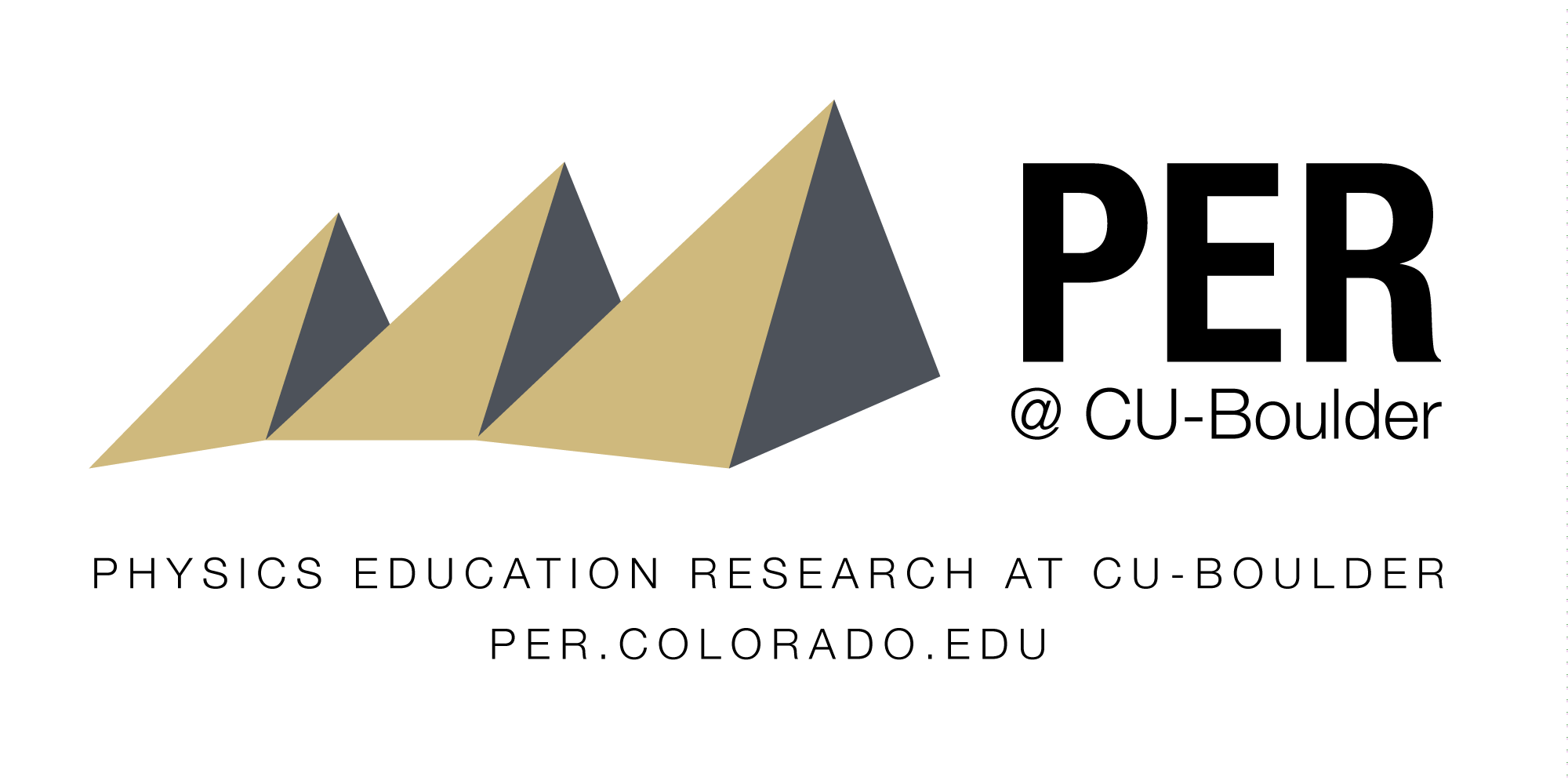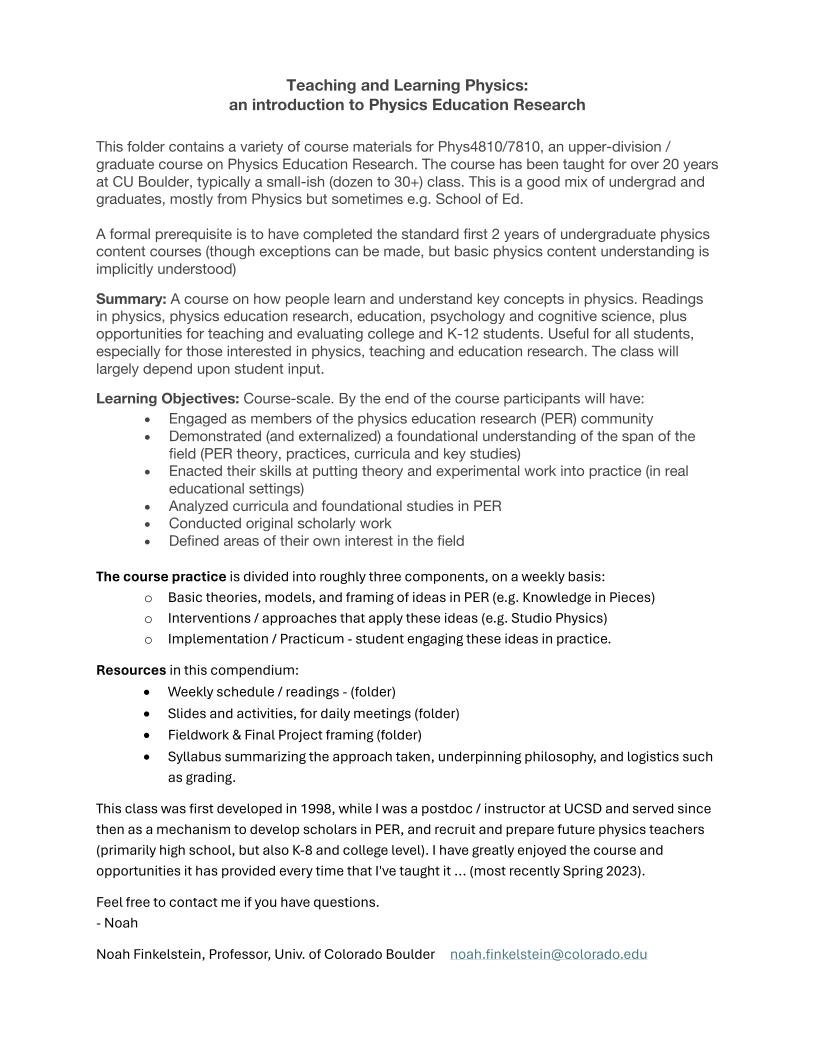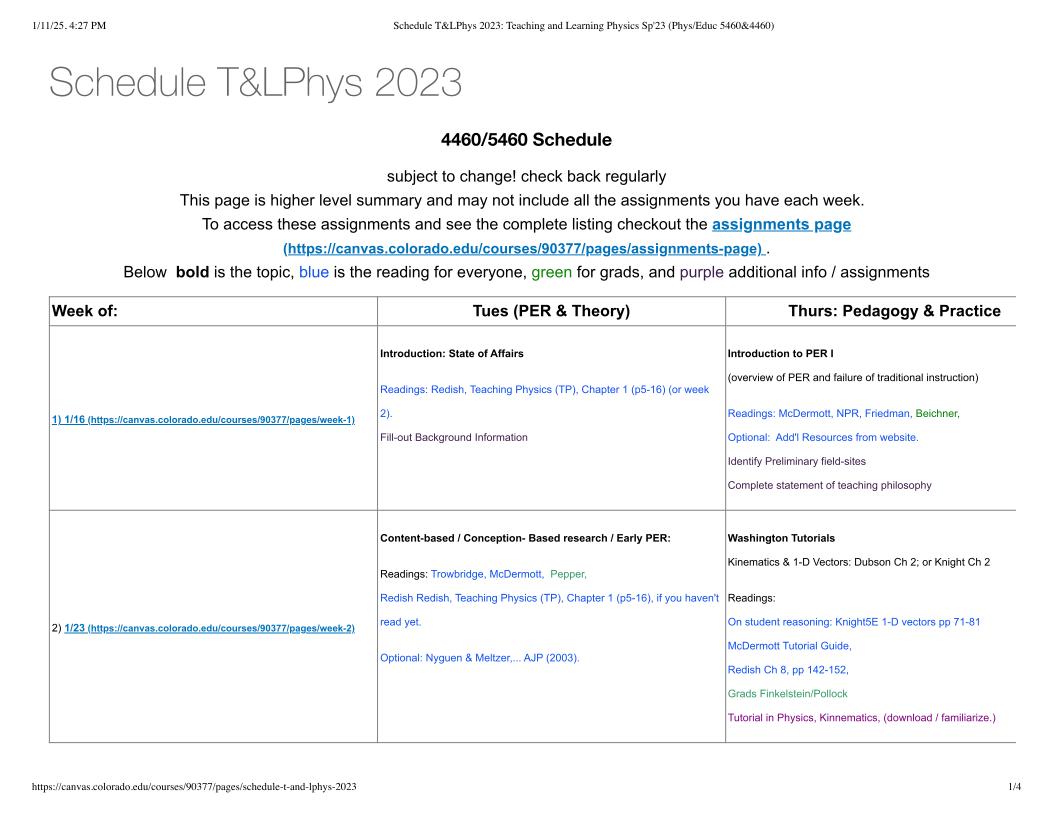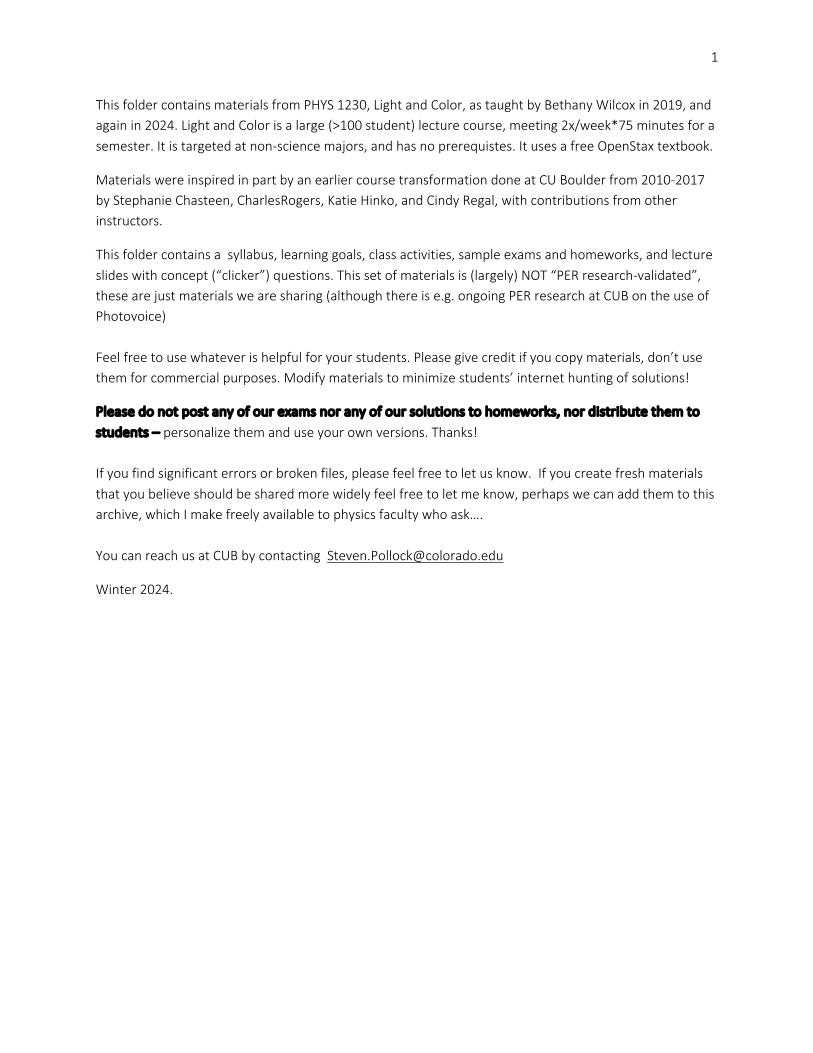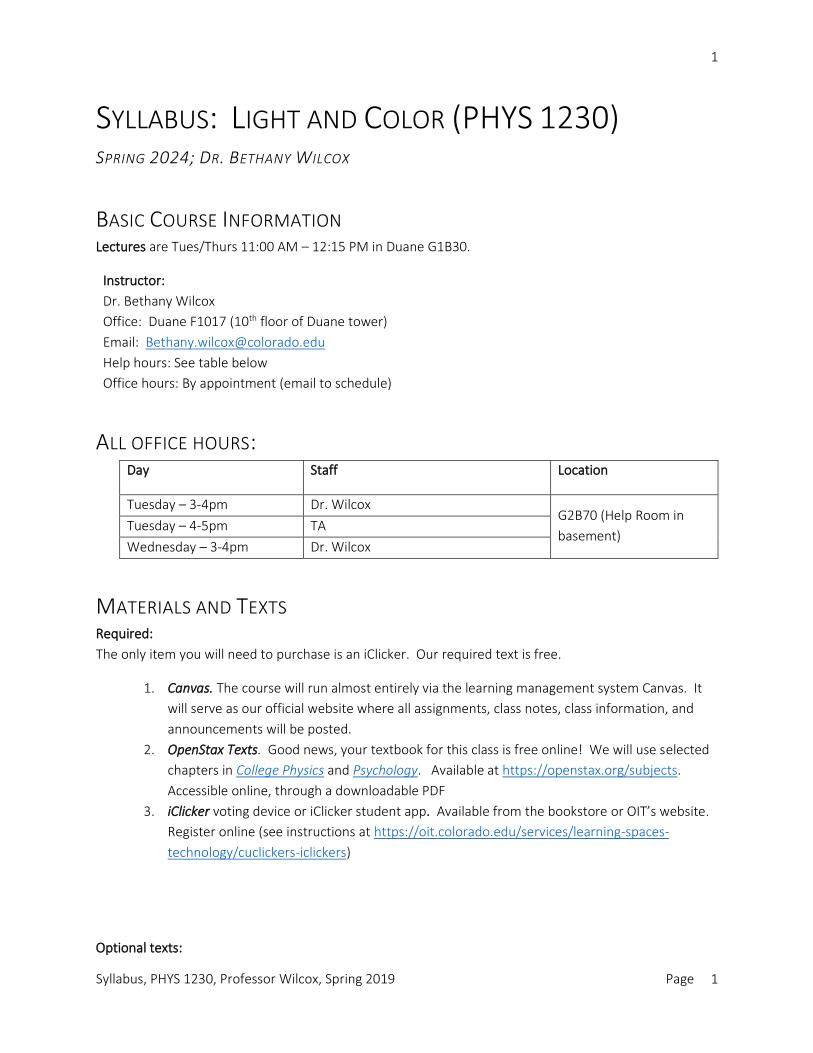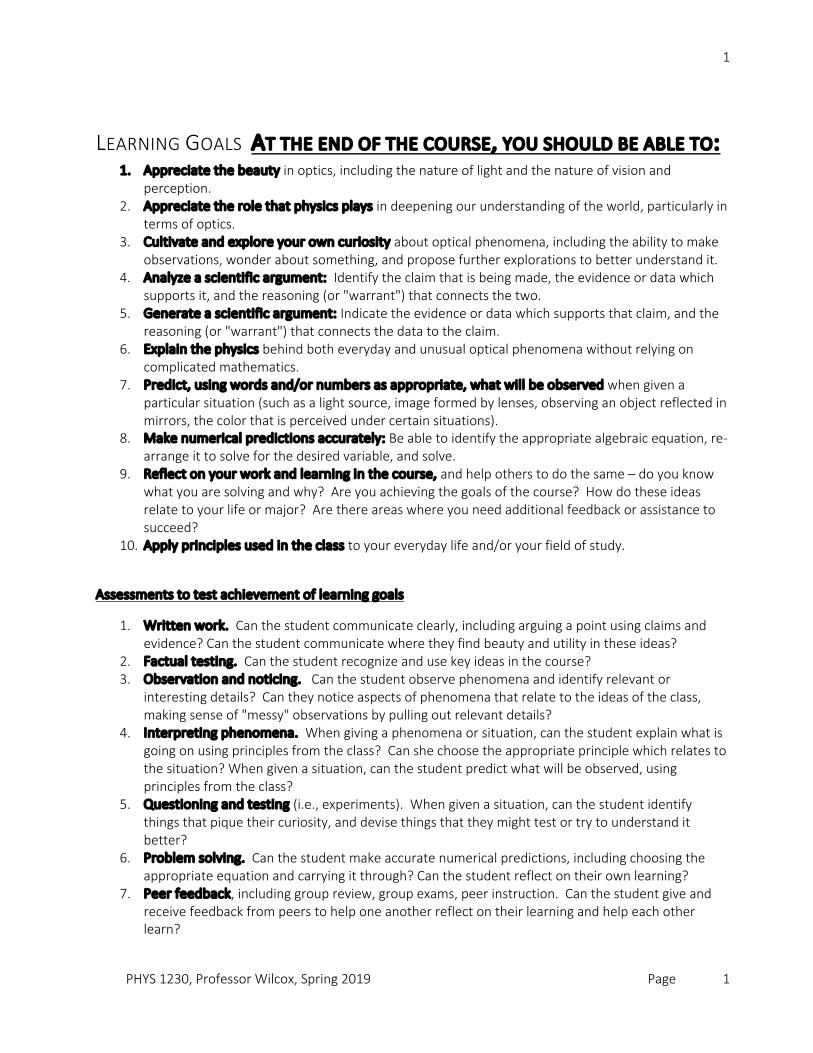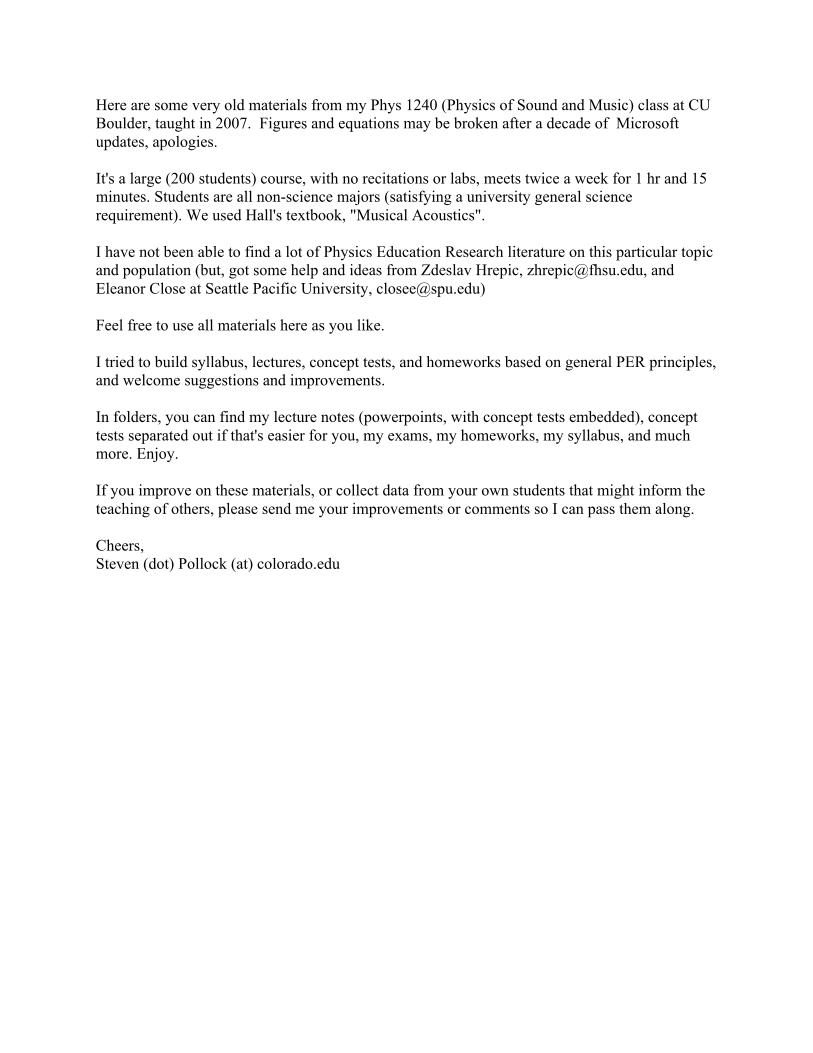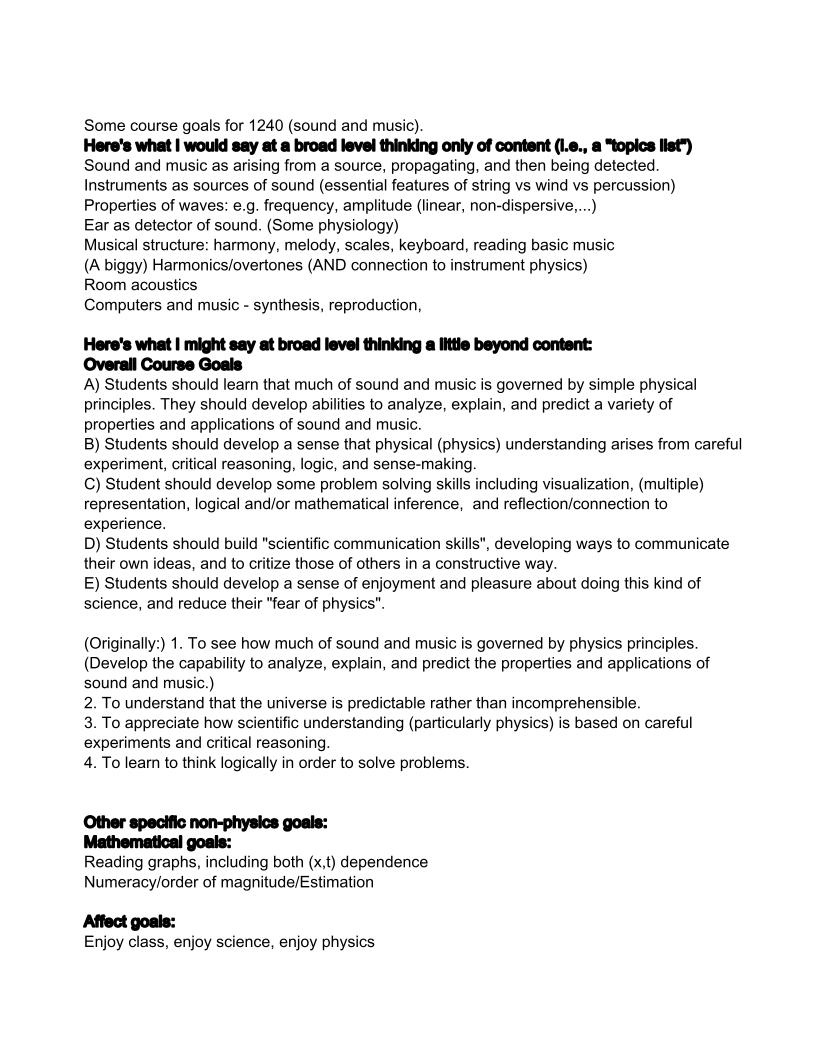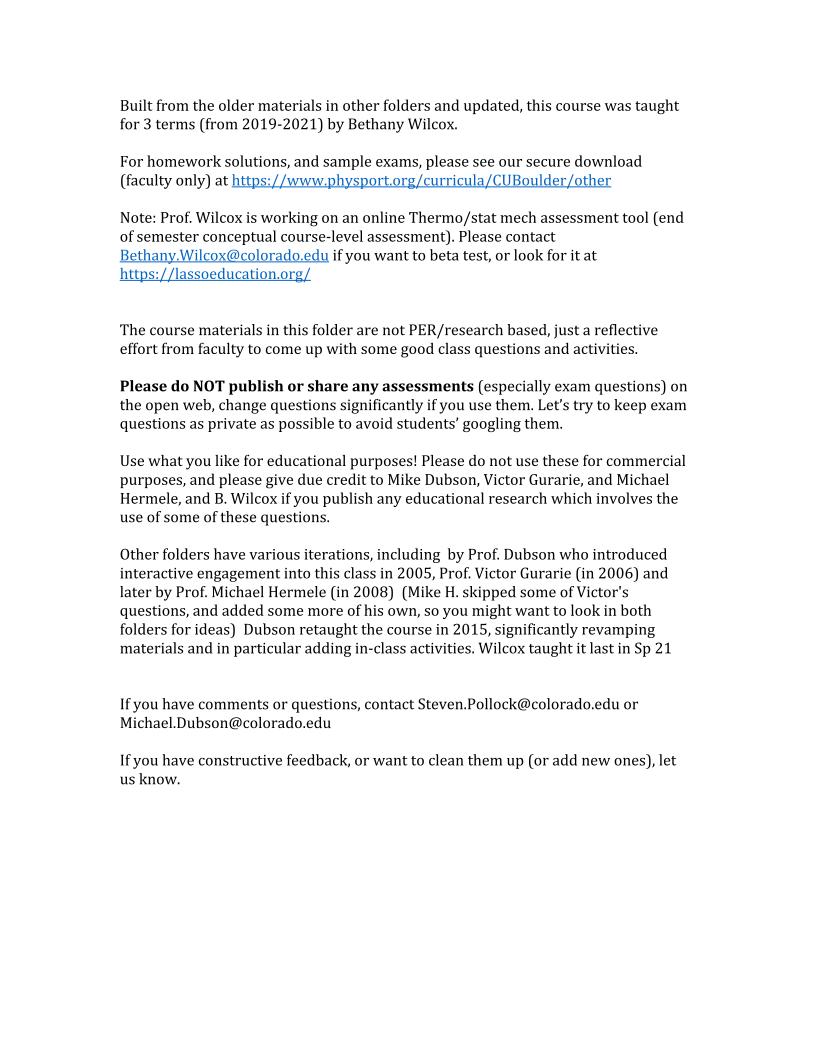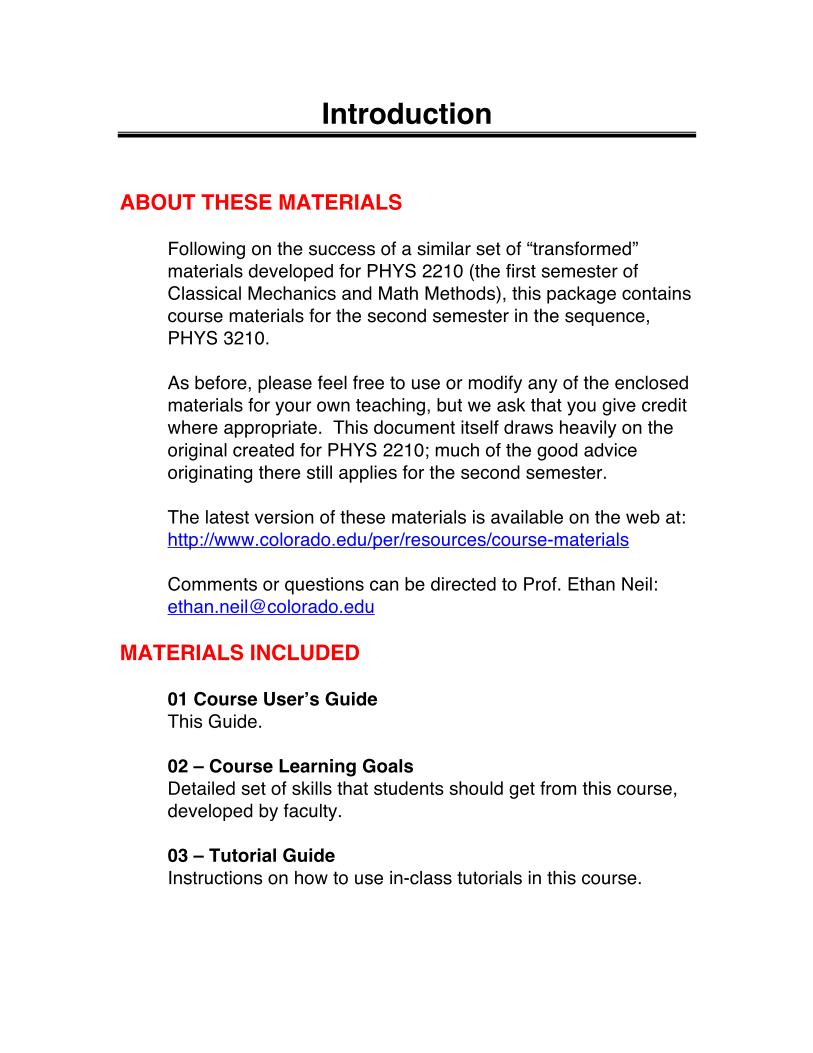The Physics Education Research group at the University of Colorado Boulder (PER@C) has developed and compiled resources for research-based instruction throughout the undergraduate curriculum. This includes materials developed as part of the CU Science Education Initiative and other research-based efforts, and materials developed later by other faculty at CU Boulder.
Requests when using and sharing:
On this site, you will find a number of materials we have borrowed or developed. Feel free to use what you like - we would like to share our materials, but also believe in giving credit to sources whenever possible (and ask that you do not use our materials for commercial purposes). We ask for your cooperation in not making any solutions you may create for the homework (and exam problems, clicker questions, etc…) available on the open web, out of respect for instructors and students at other institutions, and for maintaining the integrity of our research.
If you have questions, contributions, bug-catches, etc, please contact steven.pollock (at) colorado.edu Thanks!
Modern Physics is the third semester in our three-semester sequence of introductory physics courses.
- special relativity
- photoelectric effect
- spectra
- lasers
- Bohr and deBroglie models,
- Stern-Gerlach, entanglement and single-quanta experiments,
- matter waves and the Schrödinger equation,
- tunneling (α-decay, STM's),
- hydrogen atoms and molecular bonding,
- conductivity, semiconductors
- BECs.
Materials were originally developed for a course for engineering majors, with a focus on applications, in 2005 and 2006 by Wieman, Perkins, and McKagan (McKagan et al. 2007). They were later adapted for a course for physics majors to include special relativity by Finkelstein, Bohn, and later Rogers, Schibli, and Dessau. Finkelstein and Baily made further research-based adaptations to include content on quantum interpretation (Baily and Finkelstein 2010). Later updates by Finkelstein added a unit on diversity.
 Modern: MATERIALS DOWNLOAD
Modern: MATERIALS DOWNLOAD
The first set of materials is older, from the Science Education Initiative team (including C. Wieman, K. Perkins, S. McKagan, N. Finkelstein, and many others). It includes materials from multiple instutions dating back to 2009, and includes some homework and exam materials, lecture notes and slides, and more.
(We include this download for reference, but if you are looking for a more updated collection of materials to support your course, we recommend starting with the second set below.)
The second set of materials is from a more recent and updated implementation of the course at CU Boulder by Noah Finkelstein.
Requests when using and sharing:
On this site, you will find a number of materials we have borrowed or developed. Feel free to use what you like - we would like to share our materials, but also believe in giving credit to sources whenever possible (and ask that you do not use our materials for commercial purposes). We ask for your cooperation in not making any solutions you may create for the homework (and exam problems, clicker questions, etc…) available on the open web, out of respect for instructors and students at other institutions, and for maintaining the integrity of our research.
 Download_instructions_SEI_Modern
Download_instructions_SEI_Modern 
 Download_instructions_NF_materials
Download_instructions_NF_materials 
 Modern: Research-Based Assessment: QMCS
Modern: Research-Based Assessment: QMCS
Quantum Mechanics Conceptual Survey (QMCS) assesses conceptual material typically taught in modern physics. Topics include wave functions, probability, wave-particle duality, uncertainty principle, infinite square well, one-dimensional tunneling, energy levels. You can learn more and download the assessment from PhysPort using the link above.
 Modern: About the Course
Modern: About the Course
The archived modern physics materials are available together as a package in the Materials tab. The course calendar below (for SP11 - with SR) is the simplest way to browse the most current materials.
NOTE: the Materials download (above) contains the files.
- special relativity
- photoelectric effect
- spectra
- lasers
- Bohr and deBroglie models,
- Stern-Gerlach, entanglement and single-quanta experiments,
- matter waves and the Schrödinger equation,
- tunneling (α-decay, STM's),
- hydrogen atoms and molecular bonding,
- conductivity, semiconductors
- BECs.
Written homework was assigned on Tuesdays, and due at the beginning of class on the Thursday in the following week (i.e., 10 days later). Students were expected to complete the readings before the lecture.
| WEEK |
Tuesday Lecture | Thursday Lecture | Homework |
|
1 |
(No class) | 1. Introduction, math review |
HW 1 |
|
2 |
2. E&M review, waves & wave equations |
3. Interference, polarization, |
HW 2 |
|
3 |
4. Michelson-Morley experiment, SR postulates |
5. Time dilation, length contraction |
HW 3 |
|
4 |
6. Lorentz transformations, spacetime, addition of velocities |
7. Relativistic momentum, energy |
No HW |
|
5 |
8. Modeling in physics, intro to quantum |
Exam 1 |
HW 4 |
|
6 |
9. Photoelectric effect 1 |
10. Photoelectric effect 2, photons |
HW 5 |
|
7 |
11. Photons, atomic spectra |
12. Lasers |
HW 6 |
|
8 |
13. Bohr model, de Broglie waves |
14. Stern-Gerlach experiments |
HW 7 + |
|
9 |
15. Repeated spin measurements, probability |
16. Entanglement, EPR, quantum cryptography |
HW 8 + |
|
10 |
17. Single-photon experiments, complementarity |
18. Electron diffraction, matter waves, |
HW 9 + |
|
11 |
19. Matter waves, Review for Exam 2 |
Exam 2 |
No HW |
|
12 |
20. Wave equations, Schrodinger equation, |
21. Infinite/finite square well, tunneling |
HW 10 |
|
13 |
22. Tunneling, alpha-decay |
23. Radioactivity, STM's |
HW 11 |
|
14 |
24. Hydrogen atom 1 |
25. Hydrogen atom 2 |
HW 12 |
|
15 |
26. Multi-electron atoms, periodic table, |
Exam 3 |
No HW |
|
16 |
27. Molecular bonding, Bose-Einstein Condensates |
Review |
(Final Exam) |
The online simulations listed below were used in both lectures and homeworks for the Spring 2011 modern physics course at CSM. Most of these links lead directly to the PhET Interactive Simulations project, online simulations developed at the University of Colorado, many of them specifically for this course. There are a number of sims for all kinds of quantum phenomena that we didn't use, as well as general physics content. We would also recommend the simulations from the The Quantum Mechanics Visualisation Project at the University of St Andrews.
Note that some older sims are java or flash. (Your mileage may vary running those on modern browsers - if you want to use these in classes be aware that e.g. some will not work on phones or pads)
Weeks 1-2: (Pre-Quantum)
- Standing Waves is a versatile wave sim. We used to recommend Walter Fendt's Standing Waves but it can be tricky to run on modern computers
- RadioWave Sim (E/M waves)
- Waves Sim (Water, Sound, E/M waves)
Special Relativity:
We're aware of only a few simulations for topics from special relativity [please let us know about ones you think are good]. The special relativity lecture slides (CSM SP11) are nicely animated, but not particularly interactive. We have not tested them with students, but there are some interesting visualizations at:
- A Slower Speed of Light - Developed by Gerd Kortemeyer (MSU) while on sabbatical at the MIT Game Lab
- Space Time Travel - Visualization of the theory of relativity - Universität Hildesheim (Germany)
- Real Time Relativity - Australian National University. Supporting AJP article here
Week 6:
Week 7:
- Lasers [the best of the bunch!!]
- Neon Lights & Other Discharge Lamps
- Quantum Wave Interference
Week 8:
Week 10:
Week 13:
Week 14:
 Modern: Learning Goals
Modern: Learning Goals
(This is an early draft from 2006)
Selected topical learning goals for Phys 2130
1. Wave function and probability
- Explain how the wave function description of matter replaces the particle description of matter.
- Determine a potential energy diagram from a physical situation and vice versa.
- Recognize that quantum mechanics describes the world using an energy picture rather than a force picture.
- Predict where a particle is most likely to be, given a wave function.
- Predict the energy that a particle is most likely to have, given a wave function.
- Apply the definitions of amplitude, wavelength, frequency for classical and quantum waves.
- Determine reflection and transmission coefficients for classical and quantum waves.
2. Wave-particle duality
- Recognize that matter is described by wave functions, not by particles moving along trajectories.
- Recognize that the wave function, via the Schrodinger Equation, describes the entire dynamics of matter, but cannot be measured.
- Recognize that light is described by electromagnetic waves.
- Compare and contrast the behavior of electromagnetic waves and matter waves.
- Recognize that light comes in discrete energy packets.
- Explain how the photoelectric effect experiment proves that light comes in discrete energy packets.
- Describe how energy quantization results from boundary conditions on wave functions or other kinds of waves.
- Determine when to use wave picture and when to use particle picture and recognize that it is not random.
- Describe how the wave picture of electrons leads to quantization of energy levels in atoms.
- Recognize that “Which slit did the particle go through?” in a double slit experiment is a trick question.
3. Schrodinger Equation
- Motivate the Schrodinger Equation from conservation of energy.
- Solve the Schrodinger Equation for simple potentials.
- Sketch solutions to the Schrodinger Equation for arbitrary potentials.
- Use the Schrodinger Equation to describe tunneling and radioactive decay.
- Calculate reflection and transmission coefficients, and determine how these change with width and height of barrier.
- Describe how the solutions to the Schrodinger equation explain the shape of orbitals of atoms.
- Describe how the solutions to Schrodinger explain the numbers of electrons in each shell of an atom.
4. Quantization of energy/quantum numbers/unique states
- Recognize that things can exist only in certain discrete states; not all values of energy, angular momentum, spin, etc. are possible.
- Describe how this quantization results from wave nature of matter.
- Recognize that when things exist in certain energy states, they take on certain probability distribution functions.
- Describe how quantization explains the structure of the periodic table.
- Predict occupancy of states based on the Pauli Exclusion Principle.
- Calculate the energies of photons emitted in transitions.
5.Uncertainty principle
- Recognize that a particle in an energy or momentum eigenstate is spread out in space.
- Recognize that a localized particle does not have a well-defined energy or momentum.
- Recognize that the uncertainty principle describes a fundamental indeterminacy, not just something that we don’t know.
- Describe how the uncertainty principle results from probabilistic interpretation of wave function.
6. Superposition
- Recognize that a system can be in superposition of eigenstates, and is not necessarily always in an eigenstate.
- Predict possible outcomes of a measurement of a superposition state.
7. Operators and observables
- Predict with what probability a certain value of an observable will be measured.
8. Measurement
- Determine how a quantum mechanical system changes upon measurement.
- Recognize that this behavior is NOT simply because a measurement “disturbs the system.”
- Recognize that “What was the energy before you measured it?” is a trick question.
- Recognize that a measurement is simply an interaction with something external to the system.
- Explain why and how measuring which slit the particles go through in a double slit experiment destroys the interference pattern.
- Recognize that an eigenstate is what you get when you make a measurement, not necessarily the state that things are always in.
 Modern: Student Challenges
Modern: Student Challenges
- Review of EM Waves (Sim: Radio Waves and Electromagnetic Fields)
- ~40% of class thinks charges moving at constant speed generate light (because charges in light bulb filament move at constant speed, because a spark is a charge moving at constant speed, because they don’t see why it wouldn’t).
- Many students think EM waves consist of something physically moving up and down in space, rather than fields increasing and decreasing in magnitude. We have clicker questions to address this. There is always some confusion over wording, but also real issues of students not understanding the physics.
- We review how classical EM wave energy independent of frequency because students don’t know classical model when we get to photoelectric effect.
- Photoelectric Effect (Sim: Photoelectric Effect)
This is a much harder topic for students than professors think. For details, see McKagan et al. 2009. Common student difficulties (many can be resolved with sim):- think voltage rather than light takes electrons off plate
- think current increases with speed of electrons
- can’t explain basic function of experiment
- can’t explain classical model of light
- can’t explain why PE experiment leads to photon model of light
- A general problem that first appears here is that some students have no ability to think hypothetically and can’t separate what was expected classically from what really happens.
- Probability and Randomness and Wave particle duality (Sim: Quantum Wave Interference)
- When we ask how students visualize light, ~40% have “Bohmian” view of particle traveling alongside EM wave.
- We use sim to demonstrate how the double slit experiment shows that light must be both a wave that goes through both slits and a particle that hits the screen at a single location. This lecture led to an unexpected onslaught of deep, fundamental questions that took up nearly an entire class period. Many students ask whether the particle is actually inside wave with a definition location that we just don’t know. Students get pretty frustrated with this class.
- Rutherford Scattering (Sim: Rutherford Scattering)
- In interviews we found that after instruction some students described the plum pudding model as cloud of negative charge filled with protons. They’re probably mixing it up with the Schrodinger model.
- In interviews we found that after instruction some students described the plum pudding model as cloud of negative charge filled with protons. They’re probably mixing it up with the Schrodinger model.
- Atomic Spectra and Discharge Lamps (Sim: Neon Lights & Other Discharge Lamps)
- We teach spectra before the Bohr model in order to emphasize how Bohr was able to explain the observed spectra with his model.
- Students often have trouble with the idea that the energy of light corresponds to the difference between the levels rather than the values of the levels. They need lots of explicit practice to get this distinction straightened out.
- We get lots of questions about how the electron chooses which level to jump down to, and how it decides when to jump down. These questions are useful later for emphasizing why the Schrodinger model of the atom is better than the Bohr model.
- The simulation and associated homework really help students build a clear model of how a discharge lamp work. The one place they had trouble was relating this model to what they see in a real discharge lamp, even though we did a demo with real discharge lamps and diffraction gratings. It’s important to be really explicit in this demo about how the physical lamps relate to the model in the sim.
- When reminding students of Coulomb potential energy, they remember the equation kq1q2/r, but often don’t realize that this is the same as –ke²/r.
- The idea of how fluorescent lights work is harder for students than you might think because they have trouble with the idea that red+blue+green light looks like white light to the eye. We get a lot of questions here about how the eye works.
- Lasers (Sim: Lasers)
- We originally covered Lasers towards the end of the course, but we realized that we didn’t actually use anything other than the basics of spectra in our treatment, and the engineers got grumpy if we spent too long on fundamentals without any applications, so we moved Lasers to so that there was more emphasis on applications early in the course. This worked much better.
- When we ask students why laser beams are so powerful, it’s split 50/50 between more power in the beam and more concentrated light.
- The homework on lasers starts with basic questions about absorption and spontaneous and stimulated emission, works through the steps of building a laser and troubleshooting a broken laser, and ends with essays on why a population inversion is necessary to build a laser and why this requires atoms with three energy levels instead of two. Most students are able to give coherent explanations in these essays. Students get less frustrated by the homework if it follows a lecture demo of the sim.
- Balmer Series
- We emphasize the point that Balmer came up with his formula by playing around with numbers and didn’t know what it meant. This is probably lost on students who think all of physics is like that.
- We emphasize the point that Balmer came up with his formula by playing around with numbers and didn’t know what it meant. This is probably lost on students who think all of physics is like that.
- Bohr and deBroglie Models of the atom (Sim: Models of The Hydrogen Atom)
- For details about why and how we teach this topic, see McKagan et al. 2008.
- This is really an opportunity to teach modeling and the significance of Bohr explaining where Balmer’s equation came from and deBroglie explaining why there are fixed energy levels. This is a really difficult section for students who have trouble thinking hypothetically.
- In the Bohr model, students often mix up total and potential energy, for example, thinking that -13.6eV is the potential energy. This confusion is confounded by the way the total energy lines are drawn on top of the potential energy curves.
- Double slit and Davisson Germer experiment (Sims: Quantum Wave Interference, Davisson Germer: Electron Diffraction)
- Students have a much harder time thinking of electrons as waves than photons, because electrons have mass.
- Students often think that the size of the wave packet, rather than the wavelength, should determine the spacing of the interference pattern.
- We have noticed that students often miss the point of the Davisson Germer experiment. They remember that electrons were only detected at certain angles, but cannot explain why. They view the electrons as particles that happen to bounce off at certain angles for some reason they can’t understand, rather than recognizing how the observations can be explained by the wave nature of electrons. We have found two things that really help to address this: (1) Start with a review of the double slit experiment, a context where students understand interference much better, talking about how you would like to do this to test deBroglie’s hypothesis, and then explain why this is really hard to do and then talk about how the Davisson Germer experiment is analogous. (2) Use the Davisson Germer sim to illustrate how wave interference leads to peaks in intensity at certain angles.
- Wave functions and probability
- When we first introduce wave functions with arbitrary functions, students often don’t recognize these as waves because they think “waves” are sine waves.
- “Wave number” is usually new and unfamiliar to students, and it’s worth spending 5 minutes to discuss why we define this quantity and how it relates to wavelength.
- Wave packets and uncertainty principle (Sims: Quantum Wave Interference, Quantum Tunneling and Wave Packets, Fourier: Making Waves)
- We introduce wave packets early because they are much more intuitive than plane waves and easier to relate to “particles.”
- We introduce wave packets early because they are much more intuitive than plane waves and easier to relate to “particles.”
- Wave equations and Differential equations
- It is worth emphasizing that the way we solve differential equations in physics, by just “guessing” the solution, is completely different from the way they have been taught to solve differential equations in math classes. Many students make this section way too hard by attempting to use complicated methods they have learned in math classes.
- It is worth emphasizing that the way we solve differential equations in physics, by just “guessing” the solution, is completely different from the way they have been taught to solve differential equations in math classes. Many students make this section way too hard by attempting to use complicated methods they have learned in math classes.
- Schrodinger equation for free particle (Sim: Quantum Tunneling and Wave Packets)
- You can use the Quantum Tunneling sim to demonstrate free particles by just setting the potential to “constant.”
- Students often have difficulty understanding the meaning of complex wave functions. This can perhaps best be illustrated by the observation that students frequently ask, “What is the physical meaning of the imaginary part of the wave function?” but never ask about the physical meaning of the real part, even though both have the same physical significance.
- Potential Energy
- We have found that without explicit instruction on how to relate potential energy diagrams to physical systems, most students don’t know what a potential energy diagram means or how it relates to anything real. When we do give explicit instruction on this, students start asking a lot of questions, and it becomes clear what a struggle it is for them to make sense of it.
- The fact that we often use the symbol V for potential energy and use the words “potential” and “potential energy” interchangeably leads to a lot of students thinking that V is actually the electric potential. It is worth emphasizing repeatedly that this is NOT what it means.
- Infinite and Finite Square Wells (Sim: Quantum Bound States)
- We illustrate a finite square well with the physical example of an electron in a short wire, and illustrate an infinite square well with the same system with a really big work function. We justify why this potential energy represents this system by building it up from a microscopic model of the atoms in the wire. Before we did this, we found that students often mixed up wells and barriers. Afterwards, this happened much less.
- The practice of drawing potential energy, total energy, and wave function on the same graph leads students to confuse these quantities. We have several clicker questions to elicit and address this confusion.
- Quantum Tunneling, Alpha decay and other applications of Tunneling (Sim: Quantum Tunneling and Wave Packets)
- Language such as “potential well,” “step,” and “barrier” often leads students to interpret potential energy diagrams as physical objects. It is worth pointing out that these words are only analogies, and using examples such as an electron tunneling through an air gap where there is clearly no physical barrier.
- There is a lot of research showing that students often believe that energy is lost in tunneling, and we have incorporated a tutorial and homework designed to address this belief. Two main reasons that students think this are that they mix up energy and wave function and interpret the exponential decay of the wave function as energy loss, or that they think of a classical object penetrating a physical barrier, in which case there is always dissipation. To address the first reason, we avoid drawing the wave function and the energy on the same graph, and ask several clicker questions designed to elicit and address this confusion. To address the second reason, we emphasize that there is no dissipation in the Schrodinger equation.
- While plane waves are mathematically simple, conceptually it is quite difficult to imagine a wave that extends forever in space and time, especially when it is tunneling. The language we use to describe tunneling is time-dependent. For example, we say that a particle approaches a barrier from the left, and then part of it is transmitted and part of it is reflected. This language is difficult to reconcile with a picture of a particle that simultaneously incident, transmitted, and reflected, for all time. We find that it works much better to start instruction with wave packets, using a qualitative description and the Quantum Tunneling sim, and then show how plane waves make the math easier.
- Determining the potential energy function for a physical example such as an STM or α decay actually requires understanding many steps and approximations, and is not trivial for students. If you simply present students with these potential energy functions, they usually don’t know how to relate them to the physical systems they are supposed to represent. We have many clicker questions designed to help students build a model for the potential energy functions for STMs and α decay.
- Reflection and Transmission (Sim: Quantum Tunneling and Wave Packets)
- There is a lot of math here and it’s very easy to get lost in the math and forget why you’re doing it. When asking students to work through it in homework, it’s very useful to ask them to stop after each step in the math and explain in words what they just did.
- There is a lot of math here and it’s very easy to get lost in the math and forget why you’re doing it. When asking students to work through it in homework, it’s very useful to ask them to stop after each step in the math and explain in words what they just did.
- Superposition, measurement, and expectation values (Sim: Quantum Bound States)
- Modern Physics textbooks typically do not cover superposition and measurement. We do, because it seems to us that if you don’t talk about measurement, you don’t know what you’re actually doing in QM or how it relates to the real world.
- We have chosen to cover expectation values in some semesters and not others. It helps to relate it to more familiar examples such as grade distributions and gambling.
- Hydrogen atom (Sims: Models of The Hydrogen Atom, Rutherford Scattering, Falstad quantum atom sim (not PhET))
- It is extremely important in this section to relate the Schrodinger model of the atom back to the discussion of models of the atom earlier in the course (section 8), and show how this is the next step in the progression of models. Otherwise, students are likely to view this section as just one more example of a solution of the Schrodinger equation and not realize that we are actually talking about another model of the atom.
- We have a homework in which we ask students to work through the simulations and explain the reasons for and limitations of each models. It’s amazing how difficult this is for students.
- Multielectron atoms
- We cover this topic very qualitatively, talking about how quantum mechanics explains the patterns in the periodic table, but not doing any calculations.
- We cover this topic very qualitatively, talking about how quantum mechanics explains the patterns in the periodic table, but not doing any calculations.
- Molecular bonding and solids (Sim: Quantum Bound States)
- Most engineers don’t seem very interested in learning the quantum mechanical basis of chemistry, and many complain that this is one of their less favorite topics.
- Most engineers don’t seem very interested in learning the quantum mechanical basis of chemistry, and many complain that this is one of their less favorite topics.
- Conductivity (Sim: Conductivity)
- This section is fairly straightforward and the engineers are usually familiar with band theory and interested in seeing how it relates to what they’ve learned in this class. However, they have often learned a very specific vocabulary for talking about bands, and get frustrated when our discussion is not consistent with this vocabulary.
- This section is fairly straightforward and the engineers are usually familiar with band theory and interested in seeing how it relates to what they’ve learned in this class. However, they have often learned a very specific vocabulary for talking about bands, and get frustrated when our discussion is not consistent with this vocabulary.
- Diodes and LEDs (Sim: Semiconductors)
- In the typical representation of diodes, excess filled energy levels above a gap are represented by –’s and empty energy levels below a gap are represented by +’s. This is extremely confusing and often leads students to believe that the –’s and +’s represent excess charges, which they do not. We have several clicker questions designed to help students see what’s going on here and correctly interpret this representation.
- In the typical representation of diodes, excess filled energy levels above a gap are represented by –’s and empty energy levels below a gap are represented by +’s. This is extremely confusing and often leads students to believe that the –’s and +’s represent excess charges, which they do not. We have several clicker questions designed to help students see what’s going on here and correctly interpret this representation.
- CCDs
- This topic was pretty complicated, and required a lot of steps to understand. The students complained that it was too hard. It probably would have been fine if we spent more time on it, but we had only one lecture and it was rushed.
- This topic was pretty complicated, and required a lot of steps to understand. The students complained that it was too hard. It probably would have been fine if we spent more time on it, but we had only one lecture and it was rushed.
- Spin and MRI (Sims: Stern Gerlach Experiment, Simplified MRI)
- We cover only enough details about spin to discuss MRI and EPR. All we really say is that it’s an additional quantum number than can be measured as up or down.
- Our treatment of MRI, and our simulation, closely follows the description given in Bloomfield’s textbook How Things Work.
- EPR paradox
- We have covered this topic in one day or two. One day is pretty rushed, but possible. Throughout the course, students have been asking whether the electron really goes through both slits or we just don’t know which it went through, whether it really has an undefined momentum when its position is known or we just don’t know what it’s position is, and other similar questions. In this lecture we finally answer those questions. Some students really love this lecture, and some find it confusing and don’t get it (there are a lot of steps of hypothetical reasoning in it). I don’t know what percentage of students falls into each category.
 Modern: Research Associated with the Course
Modern: Research Associated with the Course
The papers linked below explain much of the process and rationale behind the transformations. The first part (2006) reports on the state of affairs following the first year of the process, after the course had been taught twice (in the FA05 and SP06 semesters). The second part (2011) details additional changes that were made to the materials as part of Charles Baily's dissertation project on quantum perspectives.
- C. Baily, Perspectives in Quantum Physics: Epistemological, Ontological and Pedagogical, Ph.D., University of Colorado at Boulder, 2011.
- C. Baily and N. Finkelstein, Student Perspectives in Quantum Physics, presented at the Physics Education Research Conference 2008, Edmonton, Canada, 2008.
- C. Baily and N. Finkelstein, Development of quantum perspectives in modern physics, Phys. Rev. ST Phys. Educ. Res. 5 (1), 010106 (2009).
- C. Baily and N. Finkelstein, Quantum Interpretations in Modern Physics Instruction, presented at the Physics Education Research Conference 2009, Ann Arbor, Michigan, 2009.
- C. Baily and N. Finkelstein, Interpretation in Quantum Physics as Hidden Curriculum, presented at the Physics Education Research Conference 2010, Portland, Oregon, 2010.
- C. Baily and N. Finkelstein, Refined characterization of student perspectives on quantum physics, Phys. Rev. ST Phys. Educ. Res. 6 (2), 020113 (2010).
- C. Baily and N. Finkelstein, Teaching and understanding of quantum interpretations in modern physics courses, Phys. Rev. ST Phys. Educ. Res. 6 (1), 010101 (2010).
- C. Baily and N. Finkelstein, Interpretive Themes in Quantum Physics: Curriculum Development and Outcomes, presented at the Physics Education Research Conference 2011, Omaha, Nebraska, 2011.
- C. Baily and N. D. Finkelstein, Teaching quantum interpretations: Revisiting the goals and practices of introductory quantum physics courses, Phys. Rev. ST Phys. Educ. Res. 11 (2) 020124 (2015).
- L. Deslauriers and C. Wieman, Learning and retention of quantum concepts with different teaching methods, Phys. Rev. ST Phys. Educ. Res. 7 (1), 010101 (2011).
- S. McKagan, W. Handley, K. Perkins, and C. Wieman, A Research-based Curriculum for Teaching the Photoelectric Effect, Am. J. Phys. 77 (1), 87 (2009).
- S. McKagan, K. Perkins, M. Dubson, C. Malley, S. Reid, R. LeMaster, and C. Wieman, Developing and Researching PhET simulations for Teaching Quantum Mechanics, Am. J. Phys. 76 (4), 406 (2007).
- S. McKagan, K. Perkins, and C. Wieman, Reforming a large lecture modern physics course for engineering majors using a PER-based design, presented at the Physics Education Research Conference 2006, Syracuse, New York, 2006.
- S. McKagan, K. Perkins, and C. Wieman, Deeper look at student learning of quantum mechanics: The case of tunneling, Phys. Rev. ST Phys. Educ. Res. 4 (2), 020103 (2008).
- S. McKagan, K. Perkins, and C. Wieman, Why we should teach the Bohr model and how to teach it effectively, Phys. Rev. ST Phys. Educ. Res. 4 (1), 010103 (2008).
- S. McKagan, K. Perkins, and C. Wieman, Design and validation of the Quantum Mechanics Conceptual Survey, Phys. Rev. ST Phys. Educ. Res. 6 (2), 020121 (2010).
- S. McKagan and C. Wieman, Exploring Student Understanding of Energy through the Quantum Mechanics Conceptual Survey, presented at the Physics Education Research Conference 2005, Salt Lake City, Utah, 2005.
At CU Boulder, sophomore Classical Mechanics spans two semesters, explicitly adding coverage of a number of math tools that will be (re)encountered throughout the remainder of a typical physics major's career, introducing them in the context of Classical Mechanics.
Classical Mechanics/Math Methods 1 includes Newton's laws with velocity dependent forces, rockets, energy and gravity, and oscillations with damping and drivers. Classical Mechanics/Math Methods 2 continues with Lagrangian and Hamiltonian formalism, rigid body rotation, normal modes, orbits, non-inertial frames, linear algebra and matrix methods, and calculus of variations.
The Classical Mechanics 1 course was developed through the Science Education Initiative starting in 2009 with work from S. Pollock, S. Chasteen, R. Pepper, A. Marino, D. Caballero and many others.
The course was updated by S. Pollock and E. Neil with additional in-class tutorials and lecture notes in 2022. The Classical Mechanics 2 course was developed by several faculty at CU who shared their materials, especially E. Neil, and is not associated with any education research projects.
For details about either semester, click on the appropriate course link above.
E&M at CU is a two-semester sequence of junior-level classical electricity and magnetism.
Content coverage follows the textbook of Griffiths, Introduction to Electrodynamics)
E&M 1 covers electro- and magnetostatics, roughly Ch 1-6 of Griffiths.
E&M 2 covers electrodynamics, roughly Ch 7-12 of Griffiths.
For details about either semester, click on the appropriate course link above.
Reformed course materials were developed through the Science Education Initiative starting in 2007 with work from S. Pollock, S. Chasteen, M. Dubson, C. Baily, X. Ryan and many others.
Quantum Mechanics 1 is the first semester of our two-semester sequence of quantum mechanics.
- The box above labeled "Wavefunctions first" (above left) takes you to a research-based (CU-SEI) materials collection for a course that follows the first half of Griffiths' textbook.
- "Spins first" above takes you to a materials collection for our more recent approach, which follows McIntyre's textbook and spans two semesters.
- "Quantum Information Science" opens a separate PhysPort site
This tab contains links to materials for a variety of (mostly) undergraduate courses offered at CU Boulder.
Materials in this page are not "research-validated", they did not arise from the Science Education Initiative. They are a collection of informal materials that might prove useful if you are teaching a student-centered large University-level course.
Use what you like - give credit to sources when feasible. We ask that you do not use our materials for commercial purposes. We also ask for your cooperation in not making any solutions you may create for the homework (and exam problems, clicker questions, etc…) available on the open web, out of respect for instructors and students at other institutions, and for maintaining the integrity of our research.
Our material sets include concept tests and lecture notes, and sometimes more (e.g. course goals, etc) Courses are identified by topic, with details in each tab.
 Physics I clicker questions, exams, and lecture notes
Physics I clicker questions, exams, and lecture notes
We teach a variety of introductory courses at CU. The calculus-based sequence (Phys 1110, largely engineers) serves over 1000 students/semester, split into sections of 300 (3x 50 minutes/week), and recitations (1x 50 minutes of UW Tutorials) of 28 students. A very similar course for our majors serves (Phys 1115) about 125 students/year, same format.
The main Physics 1 download is from a recent implementation of the major's course.
Materials should still be useful for any calculus-based course (and with modification, an algebra-based course, as we don't require Calculus as a prerequisite, so we use minimal amounts of it)
These materials are research-informed but not research-validated. Primary contributors are S. Pollock, M. Dubson, and D. Bolton, with contributions from many others.
 Download_instructions_Phys1
Download_instructions_Phys1 
 Physics II clicker questions, exams, and lecture notes
Physics II clicker questions, exams, and lecture notes
Physics 2 is Electricity and Magnetism.
We teach a variety of introductory E&M courses courses at CU. The calculus-based sequence (Phys 1120, largely for engineers) serves just under 1000 students/semester, split into sections of ~300 (3x 50 minutes/week), and recitations (1x 50 minutes of UW Tutorials) of 28 students. A very similar course (Phys 1125) for our majors serves about 125 students/year, same format.
We have an (old) collection of materials from an implementation in 2007, working on some updates.
Still coming - please check back (or contact steven.pollock (at) colorado.edu if you are in a hurry!)
These materials are research-informed but not research-validated. Primary contributors are S. Pollock, M. Dubson, and D. Bolton, with contributions from many others.
 Teaching and Learning Physics
Teaching and Learning Physics
Materials from a graduate level course at CUB on Physics Education Research (cross-listed for advance undergraduates) Designed by Noah Finkelstein. The course has been taught for over 20 years at CU Boulder, typically as a small-ish (10-30+ students) seminar style course. A formal prerequisite is to have completed the standard first 2 years of undergraduate physics content courses (though exceptions can be made, but basic physics content understanding is implicitly understood)
Summary for students: A course on how people learn and understand key concepts in physics. Readings in physics, physics education research, education, psychology and cognitive science, plus opportunities for teaching and evaluating college and K-12 students. Useful for all students, especially for those interested in physics, teaching and education research. The class will largely depend upon student input.
 Introduction_and_objectives
Introduction_and_objectives AB_Course_schedule_Sp23
AB_Course_schedule_Sp23 Download_instructions_TeachingandLearning
Download_instructions_TeachingandLearning 
 Light and Color
Light and Color
We teach an interactive large-lecture course called "Light and Color" to about 100 students/term, mostly non-science majors. The course is an introduction to the science of optics, with no prerequisites (and very light on math or formalism). It uses a variety of readings, including from a (free) OpenStax textbook (College Physics 2e).
Downloads below are from a recent implementation taught by B. Wilcox.
The materials are (largely) not research-validated, but were inspired in part by earlier course transformations at CU Boulder from 2010-2017 taught by Stephanie Chasteen, CharlesRogers, Katie Hinko, and Cindy Regal, with contributions from other instructors.
 Materials_readme
Materials_readme Syllabus_CUB
Syllabus_CUB Learning_goals
Learning_goals Download_instructions_Light_color_BW
Download_instructions_Light_color_BW 
 Sound and Music
Sound and Music
This course is a large introductory level class aimed at non-science majors. The materials shared here are not research-based in any way, just some materials from when S. Pollock taught the course in 2007.
 Sound_music_readme
Sound_music_readme Sound_and_music_course_goals
Sound_and_music_course_goals Sound_and_music_materials
Sound_and_music_materials 
 Thermal Physics and Statistical Mechanics
Thermal Physics and Statistical Mechanics
We teach a senior-level thermodynamics and statistical mechanics course for physics majors, following the textbook "Introduction to Thermal Physics," by Daniel Schroeder.
Materials are not research-validated, merely shared by faculty at CU including Michael Dubson, M. Hermele, V. Gurarie, and most recently Bethany Wilcox (whose latest version is featured in the download) The course has interactive elements (clicker questions, and in-class Tutorials) developed by various faculty.
 Sample_syllabus
Sample_syllabus Material_overview_thermo
Material_overview_thermo Download_instructions_Thermo
Download_instructions_Thermo 
A sample syllabus from a recent implementation of our senior level Thermo and Stat mech course
❮
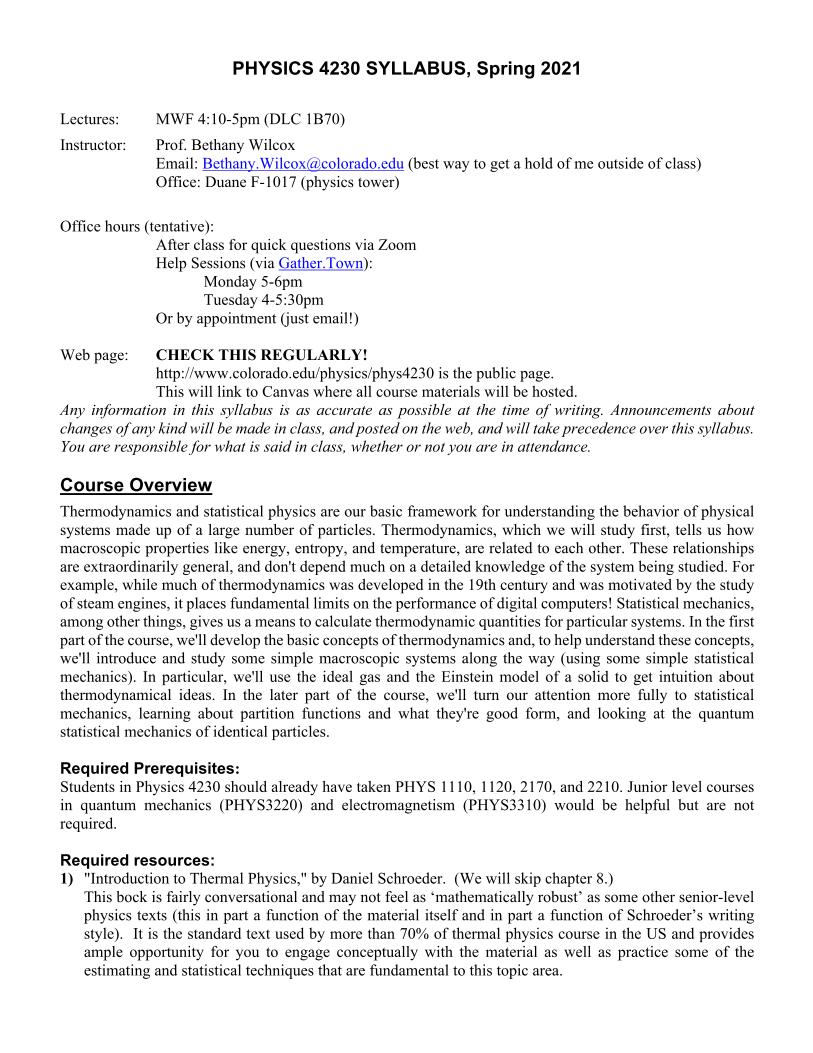 ❯
❯
Classical Mechanics 2
Class Mech/Math Methods 2 at CU continues our mechanics courses with a selection of topics including:
Lagrangian and Hamiltonian formalism, orbits, non-inertial frames, rigid body rotation, and normal modes. Math methods include linear algebra and matrix methods, and calculus of variations.
There have been no associated Education Research projects for this course, the downloads below are a collection from several faculty at CU who shared their materials, largely coming from Prof. Ethan Neil.
 CM2: MATERIALS DOWNLOAD
CM2: MATERIALS DOWNLOAD
Requests when using and sharing:
On this site, you will find a number of materials we have borrowed or developed. Feel free to use what you like - we would like to share our materials, but also believe in giving credit to sources whenever possible (and ask that you do not use our materials for commercial purposes). We ask for your cooperation in not making any solutions you may create for the homework (and exam problems, clicker questions, etc…) available on the open web, out of respect for instructors and students at other institutions, and for maintaining the integrity of our research.
 3210_Course_users_guide
3210_Course_users_guide Course_Learning_Goals
Course_Learning_Goals Download_instructions_CM2_EN
Download_instructions_CM2_EN 
An informal set of learning goals (topical and course level) for CUB's Class Mech 2 course
❮
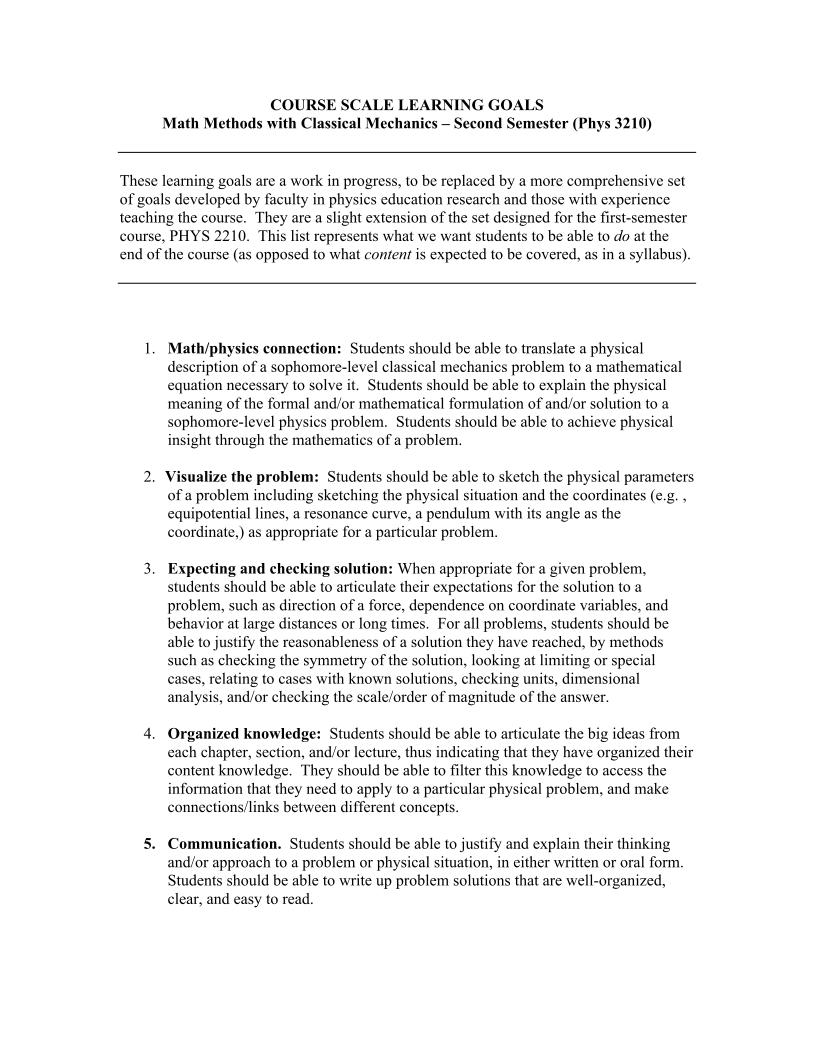 ❯
❯
